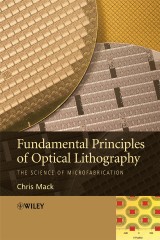Details

Fundamental Principles of Optical Lithography
The Science of Microfabrication1. Aufl.
|
62,99 € |
|
| Verlag: | Wiley |
| Format: | |
| Veröffentl.: | 11.03.2008 |
| ISBN/EAN: | 9780470723869 |
| Sprache: | englisch |
| Anzahl Seiten: | 544 |
DRM-geschütztes eBook, Sie benötigen z.B. Adobe Digital Editions und eine Adobe ID zum Lesen.
Beschreibungen
The fabrication of an integrated circuit requires a variety of physical and chemical processes to be performed on a semiconductor substrate. In general, these processes fall into three categories: film deposition, patterning, and semiconductor doping. Films of both conductors and insulators are used to connect and isolate transistors and their components. <p>By creating structures of these various components millions of transistors can be built and wired together to form the complex circuitry of modern microelectronic devices. Fundamental to all of these processes is lithography, ie, the formation of three-dimensional relief images on the substrate for subsequent transfer of the pattern to the substrate.</p> <p>This book presents a complete theoretical and practical treatment of the topic of lithography for both students and researchers. It comprises ten detailed chapters plus three appendices with problems provided at the end of each chapter.</p> <p><b>Additional Information:</b><br /> Visiting <a href="http://www.lithoguru.com/textbook/index.html">http://www.lithoguru.com/textbook/index.html</a> enhances the reader's understanding as the website supplies information on how you can download a free laboratory manual, Optical Lithography Modelling with MATLAB®, to accompany the textbook. You can also contact the author and find help for instructors.</p>
Preface. <p><b>1. Introduction to Semiconductor Lithography.</b></p> <p>1.1 Basics of IC Fabrication.</p> <p>1.2 Moore’s Law and the Semiconductor Industry.</p> <p>1.3 Lithography Processing.</p> <p>Problems.</p> <p><b>2. Aerial Image Formation – The Basics.</b></p> <p>2.1 Mathematical Description of Light.</p> <p>2.2 Basic Imaging Theory.</p> <p>2.3 Partial Coherence.</p> <p>2.4 Some Imaging Examples.</p> <p>Problems.</p> <p><b>3. Aerial Image Formation – The Details.</b></p> <p>3.1 Aberrations.</p> <p>3.2 Pupil Filters and Lens Apodization.</p> <p>3.3 Flare.</p> <p>3.4 Defocus.</p> <p>3.5 Imaging with Scanners Versus Steppers.</p> <p>3.6 Vector Nature of Light.</p> <p>3.7 Immersion Lithography.</p> <p>3.8 Image Quality.</p> <p>Problems.</p> <p><b>4. Imaging in Resist: Standing Waves and Swing Curves.</b></p> <p>4.1 Standing Waves.</p> <p>4.2 Swing Curves.</p> <p>4.3 Bottom Antirefl ection Coatings.</p> <p>4.4 Top Antirefl ection Coatings.</p> <p>4.5 Contrast Enhancement Layer.</p> <p>4.6 Impact of the Phase of the Substrate Refl ectance.</p> <p>4.7 Imaging in Resist.</p> <p>4.8 Defi ning Intensity.</p> <p>Problems.</p> <p><b>5. Conventional Resists: Exposure and Bake Chemistry.</b></p> <p>5.1 Exposure.</p> <p>5.2 Post-Apply Bake.</p> <p>5.3 Post-exposure Bake Diffusion.</p> <p>5.4 Detailed Bake Temperature Behavior.</p> <p>5.5 Measuring the <i>ABC</i> Parameters.</p> <p>Problems.</p> <p><b>6. Chemically Amplifi ed Resists: Exposure and Bake Chemistry.</b></p> <p>6.1 Exposure Reaction.</p> <p>6.2 Chemical Amplifi cation.</p> <p>6.3 Measuring Chemically Amplifi ed Resist Parameters.</p> <p>6.4 Stochastic Modeling of Resist Chemistry.</p> <p>Problems.</p> <p><b>7. Photoresist Development.</b></p> <p>7.1 Kinetics of Development.</p> <p>7.2 The Development Contrast.</p> <p>7.3 The Development Path.</p> <p>7.4 Measuring Development Rates.</p> <p>Problems.</p> <p><b>8. Lithographic Control in Semiconductor Manufacturing.</b></p> <p>8.1 Defi ning Lithographic Quality.</p> <p>8.2 Critical Dimension Control.</p> <p>8.3 How to Characterize Critical Dimension Variations.</p> <p>8.4 Overlay Control.</p> <p>8.5 The Process Window.</p> <p>8.6 H–V Bias.</p> <p>8.7 Mask Error Enhancement Factor (MEEF).</p> <p>8.8 Line-End Shortening.</p> <p>8.9 Critical Shape and Edge Placement Errors.</p> <p>8.10 Pattern Collapse.</p> <p>Problems.</p> <p><b>9. Gradient-Based Lithographic Optimization: Using the Normalized Image Log-Slope.</b></p> <p>9.1 Lithography as Information Transfer.</p> <p>9.2 Aerial Image.</p> <p>9.3 Image in Resist.</p> <p>9.4 Exposure.</p> <p>9.5 Post-exposure Bake.</p> <p>9.6 Develop.</p> <p>9.7 Resist Profi le Formation.</p> <p>9.8 Line Edge Roughness.</p> <p>9.9 Summary.</p> <p>Problems.</p> <p><b>10. Resolution Enhancement Technologies.</b></p> <p>10.1 Resolution.</p> <p>10.2 Optical Proximity Correction (OPC).</p> <p>10.3 Off-Axis Illumination (OAI).</p> <p>10.4 Phase-Shifting Masks (PSM).</p> <p>10.5 Natural Resolutions.</p> <p>Problems.</p> <p>Appendix A. Glossary of Microlithographic Terms.</p> <p>Appendix B. Curl, Divergence, Gradient, Laplacian.</p> <p>Appendix C. The Dirac Delta Function.</p> <p>Index.</p>
<p><strong>Chris A. Mack</strong>, Vice-President of Lithography Technology, Lithoguru.com.
Microlithography is the main technical driving force behind one of the most important phenomenon in the history of technology - microelectronics and the incredible shrinking transistor. These dramatic increases in electronic functionality per unit cost each year for early five decades, have transformed society. The gating piece of technology in this marvel of manufacturing progress has always been the process of lithography - the photochemical printing of circuit patterns onto semiconductor wafers. <p>This text attempts a difficult task - to capture the fundamental principles of the incredibly fast-changing field of semiconductor microlithography in such a sway that these principles may be effectively applied to past, present and future microfabrication technology generations. Its focus is on the underlying scientific principles of optical lithography, rather than its practice. It will serve equally well as a university textbook (each chapter has an extensive set of problems) and as an industry resource.</p> <p>Much of the material contained in this book is, of course, a tutorial review of the published literature on lithography and related sciences, but a significant portion is new work, never before having been published. there is no other single book that covers the wide breadth of scientific disciplines needed in the practice of optical microlithography. The major topics covered within this text are optics (imaging and thin film interference effects), photoresist chemistry (chemical reactions, diffusion, and development phenomenon), lithography as a manufacturing process (process control, critical dimension control, and overlay), and resolution enhancement technologies.</p>


















